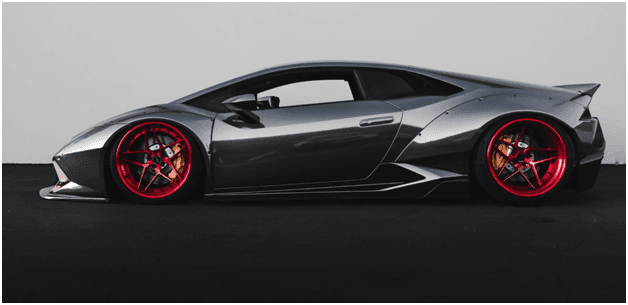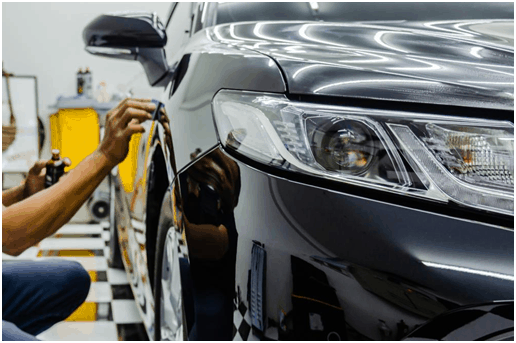How Does Car Ceramic Coating Work?
Nothing is more important to car owners than maintaining the dazzling, clean appearance of their vehicle. These owners take pride in showing off their cars, and are willing to go to great lengths to ensure that their main mode of transport continues looking eye-catchy and attractive.
Recent technological innovations have enabled car owners to treat their vehicles so that they can continue looking as immaculate and new as the day they were purchased. Plenty of car waxes and sealants are available on the market to help car owners maintain the look of their vehicles; however, none of them are as innovative as the ceramic coatings used by car detailers today.
These ceramic coatings do a great job of maintaining the appearance of new paint and protecting it from blemishes. This type of car paint protection technology has been growing in popularity for years due to its high durability and the reliable protection it provides.
In order to understand why car ceramic works so well compared to other paint protection products, we first have to take a look at the development of car paint protection products.
Origin of car paint protection products.
The first car paint protection products were made from animal fat in Germany in the early 1800s. These products were applied as lacquer to horse carriages to keep them looking well-maintained and polished. Other developments in surface protection products would occur over the next century as people looked for ways to polish furniture.
It wasn’t until the 1920s when 3M developed the first waterproof sandpaper from wax that car manufacturers first took an interest in surface protection products. 3M would later produce masking tape in 1925. This tape allowed car manufacturers to perform two-tone paint jobs on the vehicles they produced and sold.
In 1944 a company called Plastone invented the first commercially available car polish. Plastone called this polish “Turtle Wax” due to the turtle-shell-like finish the product gave to cars it was used on. This product is still available today and is made from Carnauba wax and oils.
When car wax is applied to the surface of a car it functions as a protective layer between the car’s paint and its surroundings. This substance sits on top of the paint and is not bonded to it in any way.
Modern car paint protection products.
The first polymer sealant was introduced by Dupont in 1970. Paint sealers are synthetic products made from polymers that are incredibly durable and resilient. This makes them ideal as protective coatings for vehicles.
Unlike wax, the layer of sealant that is applied to a car’s exterior is engineered to bond with the surface of the paint. This makes sealant far more durable than wax, and a better option for protecting the paint job on a car.
Many types of car sealants have been created and sold since they were first introduced in the 70s, but the next big innovation in car paint protection technology would not occur until the 21st century.
Car ceramic coating products.
In 2010, Nanoshine Ltd released the first car ceramic coating products. This new form of car paint protection uses nanotechnology to keep the paint on cars free from scratches and blemishes.
These coating products usually contain silicon-dioxide (also known as silica) which chemically bonds to the car’s paint when it is applied and cured. This bonding process effectively fills any pores in the car’s paint surface to prevent water and contaminants from getting through and damaging the paint job.
The compound used in car ceramic coatings is also hydrophobic, meaning that it repels water. If water falls onto a vehicle that has a layer of ceramic coating, it will bead together and slide off the vehicle’s surface.
If the same scenario were repeated with an untreated vehicle, the water would pool together and sit on the car’s surfaces. This sitting water could create water spots on the paint surface and tarnish its appearance.
The added advantage of the bonding process between the coating and the paint surface is that it makes the ceramic coating a lot more durable and difficult to remove than wax.
How do car ceramics work with paint?
Most factory paint finishes consist of a combined base coat and clear coat system. Paint is applied to vehicles in two stages: first the base coat, and then the clear coat.
The base coat provides the car with it’s primary paint color. This is the color that most people will associate with the vehicle. The clear coat is a transparent coating that is added on top of the base coat. This clear coat is similar to paint, but without any pigment.
The clear coat adds depth and a glossy finish to the look of the car. It is also used to protect the base paint from air and from fading under UV light. This enables the paint to continue looking new for a long period of time.
However, these clear coats are not very good at repelling water, chemicals or dirt. They are also easy to pierce and scratch. This clear coat layer could be partially protected using wax or sealants, but they were only moderately effective at protecting the paint from heat or chemical damage.
In addition to this, waxes and sealants did not protect the paint from scratches, and also required frequent application. It wasn’t until ceramic coatings were introduced that car paint could be effectively protected against water, chemicals, and UV rays.
Why you should use car ceramics.
Car ceramics are known for their durability compared to wax and sealants. They are also great at protecting your vehicle’s paint job from dust, dirt, contaminants, and UV rays. Each of these elements can damage your car’s paint job, so it’s important to take proactive measures and protect your vehicle against them.
Car ceramics typically last for years and provide better protection than car wax, which needs to be reapplied every few months. They are considered semi-permanent, in the sense that the ceramic layer will remain present on your car’s surfaces until it is abraded away. The ceramic should function as a resilient, sacrificial protection layer until then.
Professional vs DIY car ceramics.
There are numerous types of car ceramics available today. Most of the variants available on the market contain silicon dioxide along with other additives to enhance the properties of the coating such as hardness, water repelling ability, and shine. Each of these products utilizes the same nanotechnology that bonds with the car’s painted surface for better protection.
Car ceramics usually have to be applied by trained professionals as the process can be difficult to perform without the right tools and set-up. Professional car ceramic application is performed in a sealed and contaminant-free facility after the paint has been touched-up or repaired and the surfaces have been stripped of contaminants.
DIY ceramic coatings were introduced to the market recently and have been gaining popularity with car owners. These nano-ceramic coatings use similar technology to their professional counterparts, but are easier to apply and feature a less rigorous application process.
The application processes for both professional and DIY ceramics requires the vehicle to be prepared before applying the ceramic layer. For the DIY approach, this is as simple as washing and drying the car by hand, cleaning the surfaces with a clay bar, and then rinsing them with isopropyl.
Applying a ceramic coating professionally involves a more tedious prepping process in which the vehicle’s paint may be touched up before a layer of primer polish is applied to the car. The vehicle is then rinsed with isopropyl similar to the DIY approach.
In the professional approach, the ceramic coating is carefully applied to the vehicle in a series of sections. Some car detailers offer vehicle owners the option of applying multiple ceramic layers for added protection. Once the coating has been applied, it is left to cure under heat lamps overnight.
Following the curing process, the ceramic layer will automatically continue to harden for up to 30 days. The car should not be washed during this time to ensure that the layer forms properly.
In the DIY approach, drops of ceramic fluid are added to an applicator sponge wrapped in a cloth. This cloth-wrapped sponge is then used to wipe ceramic fluid onto the vehicle’s body in sections. The vehicle is then left to sit for a few minutes to let the fluid dry.
The vehicle’s surfaces are then buffed to remove any ceramic residue. The curing process can vary based on the ceramic manufacturer’s instructions, but the vehicle usually has to be parked indoors for 24 to 48 hours under room temperature conditions.
Unlike the professional approach, the DIY approach does not require a heat lamp for curing.
What’s the best kind of ceramic coating for me?
Ceramic coatings come in many varieties. Some are easy to apply by hand, but also tend to erode easily. Others last a long time, but tend to be expensive and have to be applied by professionals. If you’re willing to spend extra to keep your car’s paint job looking new and vibrant, you should have your ceramic coating applied by a professional car detailer.




